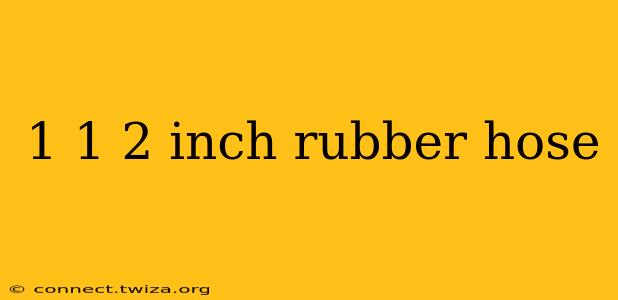Finding the right rubber hose for your needs can feel overwhelming. With so many types, sizes, and applications, knowing where to start can be tricky. This guide focuses specifically on 1 1/2 inch rubber hoses, exploring their various uses, materials, and considerations for purchase. We'll also address some frequently asked questions to help you make an informed decision.
What are the common uses for a 1 1/2 inch rubber hose?
A 1 1/2 inch rubber hose boasts versatility, making it suitable for a wide array of applications. Its size makes it ideal for tasks requiring a balance between capacity and maneuverability. Common uses include:
- Industrial applications: Transferring liquids, slurries, or air in manufacturing processes. The hose's durability makes it suitable for harsh environments.
- Agricultural irrigation: Delivering water to crops, although larger diameter hoses might be preferred for larger fields.
- Construction and demolition: Handling water or other materials during various processes.
- Drainage: Removing water from flooded areas or construction sites.
- Marine applications: Used in bilge pumping or other marine systems (though marine-specific hoses are often preferred).
What types of materials are used in 1 1/2 inch rubber hoses?
The material composition significantly impacts the hose's durability, flexibility, and chemical resistance. Common materials include:
- Natural Rubber: Offers excellent flexibility and resilience, but may be susceptible to degradation from certain chemicals and UV exposure.
- Synthetic Rubber (e.g., EPDM, Neoprene, Nitrile): Synthetic rubbers provide enhanced resistance to chemicals, temperature extremes, and UV light, depending on the specific type. EPDM is often chosen for its excellent weather resistance, while Nitrile excels in oil and fuel resistance.
- Reinforcement: Many 1 1/2 inch rubber hoses incorporate reinforcement layers (like textile or wire braiding) to increase strength and prevent kinking or collapsing under pressure.
What is the difference between different types of 1 1/2 inch rubber hoses?
The differences stem primarily from the materials used and the intended application. A hose designed for high-pressure industrial applications will differ significantly from one intended for garden irrigation. Key distinctions include:
- Pressure rating: The maximum pressure the hose can safely withstand. This is crucial for safety and preventing leaks or bursts.
- Temperature range: The operating temperature limits of the hose. Some hoses are designed for extreme temperatures, while others are suited for more moderate conditions.
- Chemical resistance: The hose's ability to withstand contact with specific chemicals. This is vital in industrial settings where the hose might be exposed to corrosive substances.
- Flexibility and durability: A balance between flexibility for easier handling and durability to withstand wear and tear.
How do I choose the right 1 1/2 inch rubber hose for my needs?
Selecting the appropriate hose involves careful consideration of several factors:
- Intended application: What will the hose be used for?
- Pressure requirements: What is the maximum pressure the hose will experience?
- Fluid compatibility: What type of fluid will be transported?
- Temperature conditions: What temperature range will the hose operate in?
- Length and flexibility: How much hose length is needed, and how important is flexibility?
- Budget: Hoses made of different materials and with varying construction will have different price points.
What are the common sizes and lengths of 1 1/2 inch rubber hoses?
While the inner diameter is consistently 1 1/2 inches, the outer diameter will vary depending on wall thickness and reinforcement. Lengths are highly variable, ranging from a few feet to several hundred feet, depending on manufacturer and availability. It's best to check with your supplier for specific length options.
This guide provides a comprehensive overview of 1 1/2 inch rubber hoses. Remember to carefully consider your specific needs and consult with a hose specialist if you require assistance in selecting the right hose for your application. Choosing the wrong hose can lead to inefficiency, damage, and even safety hazards. Prioritize safety and ensure the hose you choose meets all relevant standards and regulations.
